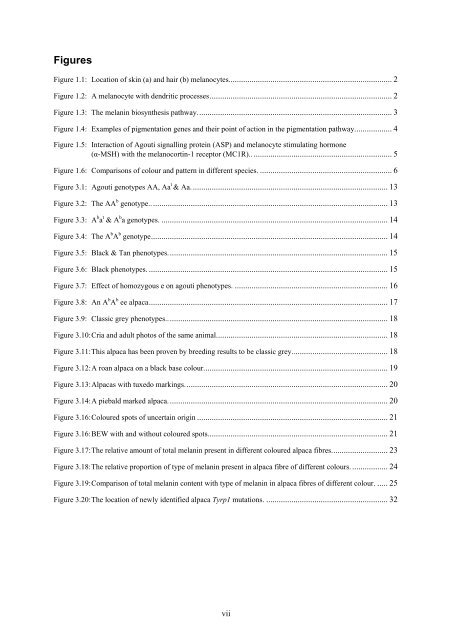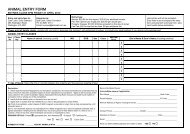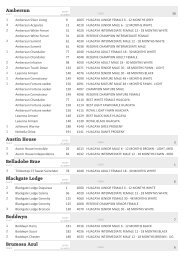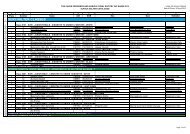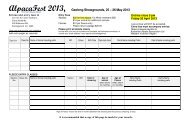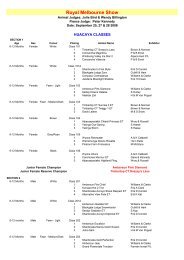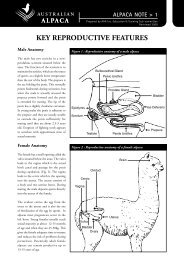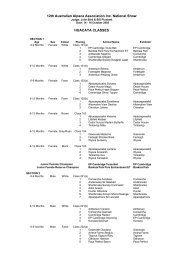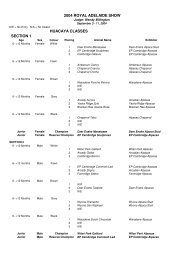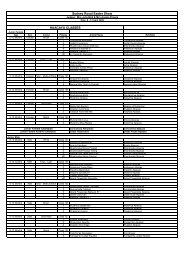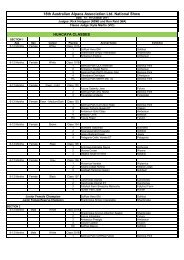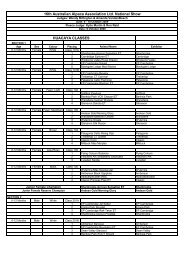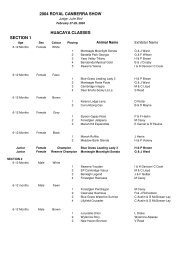Inheritance of White Colour in Alpacas - Australian Alpaca Association
Inheritance of White Colour in Alpacas - Australian Alpaca Association
Inheritance of White Colour in Alpacas - Australian Alpaca Association
Create successful ePaper yourself
Turn your PDF publications into a flip-book with our unique Google optimized e-Paper software.
Figures<br />
Figure 1.1: Location <strong>of</strong> sk<strong>in</strong> (a) and hair (b) melanocytes. ............................................................................. 2<br />
Figure 1.2: A melanocyte with dendritic processes ....................................................................................... 2<br />
Figure 1.3: The melan<strong>in</strong> biosynthesis pathway. ............................................................................................ 3<br />
Figure 1.4: Examples <strong>of</strong> pigmentation genes and their po<strong>in</strong>t <strong>of</strong> action <strong>in</strong> the pigmentation pathway. ................. 4<br />
Figure 1.5: Interaction <strong>of</strong> Agouti signall<strong>in</strong>g prote<strong>in</strong> (ASP) and melanocyte stimulat<strong>in</strong>g hormone<br />
(α-MSH) with the melanocort<strong>in</strong>-1 receptor (MC1R).. .................................................................. 5<br />
Figure 1.6: Comparisons <strong>of</strong> colour and pattern <strong>in</strong> different species. ............................................................... 6<br />
Figure 3.1: Agouti genotypes AA, Aa t & Aa. ............................................................................................. 13<br />
Figure 3.2: The AA b genotype.. ................................................................................................................ 13<br />
Figure 3.3: A b a t & A b a genotypes. ............................................................................................................ 14<br />
Figure 3.4: The A b A b genotype ................................................................................................................. 14<br />
Figure 3.5: Black & Tan phenotypes. ........................................................................................................ 15<br />
Figure 3.6: Black phenotypes. .................................................................................................................. 15<br />
Figure 3.7: Effect <strong>of</strong> homozygous e on agouti phenotypes. ......................................................................... 16<br />
Figure 3.8: An A b A b ee alpaca .................................................................................................................. 17<br />
Figure 3.9: Classic grey phenotypes.. ........................................................................................................ 18<br />
Figure 3.10: Cria and adult photos <strong>of</strong> the same animal. ................................................................................. 18<br />
Figure 3.11: This alpaca has been proven by breed<strong>in</strong>g results to be classic grey.. ............................................ 18<br />
Figure 3.12: A roan alpaca on a black base colour. ....................................................................................... 19<br />
Figure 3.13: <strong><strong>Alpaca</strong>s</strong> with tuxedo mark<strong>in</strong>gs. ................................................................................................ 20<br />
Figure 3.14: A piebald marked alpaca. ........................................................................................................ 20<br />
Figure 3.16: <strong>Colour</strong>ed spots <strong>of</strong> uncerta<strong>in</strong> orig<strong>in</strong> ........................................................................................... 21<br />
Figure 3.16: BEW with and without coloured spots. ..................................................................................... 21<br />
Figure 3.17: The relative amount <strong>of</strong> total melan<strong>in</strong> present <strong>in</strong> different coloured alpaca fibres. .......................... 23<br />
Figure 3.18: The relative proportion <strong>of</strong> type <strong>of</strong> melan<strong>in</strong> present <strong>in</strong> alpaca fibre <strong>of</strong> different colours. ................. 24<br />
Figure 3.19: Comparison <strong>of</strong> total melan<strong>in</strong> content with type <strong>of</strong> melan<strong>in</strong> <strong>in</strong> alpaca fibres <strong>of</strong> different colour. ..... 25<br />
Figure 3.20: The location <strong>of</strong> newly identified alpaca Tyrp1 mutations. .......................................................... 32<br />
vii


